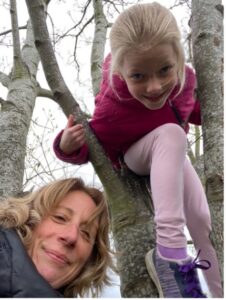Movement
Healthy Movement for Life

Can you jump, climb, crawl?
Can you throw and catch and balance on one foot?
Can you get up off the floor without using your hands?
How often do you play?
Last w
We jumped, climbed, crawled, and balanced…. She walked on walls, walking along fences and gates a few feet off the ground, jumping from pillar to pillar with a significant gap (and drop) which she navigated brilliantly and all with a little hand-holding or picking up from me. We climbed on climbing frames and monkey bars, climbed trees, swung to see who could get the highest, ran, and balanced, and it wasn’t just her doing it; I was 100% involved and committed too.
That ignited curiosity in me. If you’re an adult, how often do you play? What does playing look like for you? Can you balance on walls, jump, hang on the monkey bars, or climb on a climbing frame? How do you feel when you swing on a swing?
Do you hold limiting beliefs that prevent you from doing those things?
Admittedly, it might take a bit of practice and determination if you haven’t done that in a long time, but building some mobility and some strength to gain those movements back, is totally possible. We used to when we were children, and my 7-year-old friend is a great example of that.

I know I’m nearly 49, but I think I’m really 7 on the inside. Here we are, up her favourite tree which has been named “Oak” (it’s not an oak tree, but we’ll roll with it). Here she is, up “Oak”. The second image is of her in the same place as in image one, but I climbed the tree to her spot too.
If we look at children and how they move, we can learn so much about what our bodies and brains need. They enjoy calculated risk; they develop the skills to problem solve, which in turn helps them to manage risk, make decisions based on risk, and can quickly decide whether that risk is worth taking. And it all starts with play.
For me, playing is moving. An opportunity to move in lots of different ways that bring me joy. My brain lights up as I problem-solve how I might navigate the challenge. My joints, bones and muscles, tendons, and ligaments get to experience moving beyond my own limiting boundaries and in ways that may not be linear. In turn, my brain is challenged to experience the new experience.
Variety is the spice of life
What our bodies and brains need is variety, and we need to think of movement as money in the bank. Saving up for our future. Everything you do is in preparation for later life (just as my 7-year-old friend demonstrates) to enable you to continue to live a fulfilling life with full cognition without falling and breaking your hip, giving you the tools to reach the top shelf of your cupboard or to crawl under the bed looking for that missing sock that you took off in the middle of the night (I have very cold feet!). There is a big difference from hitting the gym 3 times a week for 60-90 minutes and being sedentary the rest of the time and moving for life. In order to move for life, consider the following eight functional movements and if you are able to incorporate them in your movement practice:
| PUSH | TWIST | BOUNCE | SQUAT |
| PULL | BEND | HANG | LUNGE |
Are you able to work out which of the functional movements is included in your movement practice and which of the functional movements it doesn’t have? Can you find a creative way to include some of these movements?
What if you were to play when you move? What would that look like for you? How could you incorporate a little play into your day?
We all know we need to move more. Our sedentary lifestyles don’t serve us, but everyone needs to work. I do too, and for many of us, that means spending more time at the computer, sitting (unless you have a standing desk), and moving far less than our bodies are designed to.
The NHS guidelines suggest at least 150 minutes of moderate intensity activity a week or 75 minutes of vigorous-intensity activity a week spread over 4-5 days. It’s medically proven that people who exercise regularly are likely to reduce the risk of type 2 diabetes, early death, osteoarthritis, hip fractures, falls, depression, heart disease, and dementia, to name a few.
But let me talk about exercise for a moment ….
The word exercise makes me think of being trapped in a cage and running on a wheel like a hamster to check a box that says I’ve exercised. Movement and play, however, is something that I just do. It’s a part of me; it’s who I am. I am a mover. Not an exerciser. It might sound like semantics, but I want to inspire my clients, to simply move and find joy in whatever that looks like to them.
I’d love for you to write to me and tell me what that looks like for you.